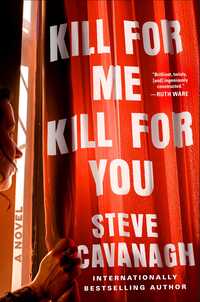Kill for Me, Kill for You by Steve Cavanagh
 Wednesday, March 20, 2024 at 11:53AM
Wednesday, March 20, 2024 at 11:53AM 
Published by Atria Books on March 19, 2024
One of the main characters in Kill for Me, Kill for You is a violent crime victim. Two others are mothers of murder victims. The last key character is an older cop named Farrow. Farrow “closed cases that nobody else could.” Farrow is the stereotype of a dedicated cop who fights through back pain and never married because he devotes all his time to catching bad guys. He is, in a word, boring.
Ruth was stabbed multiple times by a serial killer with blue eyes who breaks into houses and kills women. The cops call the serial killer “Mr. Blue Eyes” based on the description that Ruth, as the only survivor of his murder spree, was able to provide. A siren spooked Mr. Blue Eyes so he fled before he could finish stabbing Ruth to death. Now Ruth is too paranoid to leave her home (which is a bit irrational since she was stabbed in her home) and counts on her dutiful husband Scott to protect her.
Scott bulked up after being bullied as a teen. He’s a former prosecutor who loved to put bad guys away, making him another boring character but a suitable shield to whom Ruth is Velcroed. Steve Cavanagh tells us over and over that Scott is a perfect husband who will always protect his wife. When the plot takes its first twist, this trait turns out to be unfortunate for Scott.
Amanda and Naomi are mothers whose kids were murdered. Amanda’s six-year-old was found in a dumpster (naturally, because Cavanagh wants to horrify the reader without being overly graphic about the crime details). Her husband killed himself a week later.
Amanda believes her daughter was killed by Wallace Crone, a wealthy stockbroker, because a camera caught an image of someone who looks like Crone walking with a girl who looks like the daughter. The reader is presumably meant to share Amanda’s outrage that the legal system won’t put Crone behind bars based on suspicions about his guilt. Amanda has been stalking Crone (she plans to shoot him when she gets the chance) and, reasonably enough, he’s suing her for harassment. The reader is apparently meant to be outraged by that, as well.
Naomi’s daughter was found dead in a vacant lot. The daughter’s diary indicated that she’d been having sex with her teacher, Frank Quinn. Naomi believes Quinn killed Naomi to protect himself. Her suspicion goes nowhere because it’s unsupported by evidence.
Naomi and Amanda meet in a support group for traumatized mothers. The group requires its members to identify themselves by fictitious names. Amanda and Naomi become friends. They soon discover a mutual frustration that the legal system won’t convict people of crimes in the absence of clear evidence. Naomi proposes a scheme that she has taken from the Hitchcock film, Strangers on a Train. If Amanda kills Quinn and Naomi kills Crone, Naomi explains that the murders will go unsolved. Neither woman has a motive to kill her victim, while the woman who does have a motive will be surrounded by witnesses who can establish her alibi for the moment of the murder.
With that setup, Cavanagh needed to tweak the Strangers on a Train plot to avoid the perception that he was stealing the story outright. To avoid spoilers, I’ll avoid revealing the tweaks. Suffice it to say that, as in Strangers on a Train, a murder ensues. In fact, Cavanagh adds more murders before the novel ends. And as in Strangers on a Train, the dual murder scheme does not proceed as planned. I imagine that most readers will see that coming. As the reader will anticipate, the dual murder plot involving Amanda and Naomi will eventually tie into the story involving Ruth and her fear of the blue-eyed serial killer.
With the possible exception of Farrow, who is just too dull to care about, none of the characters deserve the reader’s sympathy. It’s one thing to be a crime victim. It’s quite another to think that your status as a victim entitles you to seek revenge. Cavanagh makes heroic efforts to seduce the reader into viewing Amanda as a relatable human being, but a person whose life is driven by the desire for revenge isn’t a person anyone should want to know.
The story builds toward a conclusion that is meant to be suspenseful. By that point, I had given up on caring about the outcome. The plot acquires energy in the closing chapters — another murder is imminent — but the intended victim isn’t a character in whom a reader will have made an emotional investment. The penultimate dramatic scene is so contrived that it left me laughing. A bad guy babbles away, explaining the plot from his perspective like a Bond villain, giving good guys the time they need to thwart him. Really?
While the story earns points for following an unexpected course, the plot isn’t remotely believable. Apart from a psychopath whose behavior is consistent with mental illness, the story depends on characters behaving stupidly. People are certainly capable of stupid behavior, but these are supposedly intelligent characters. A forced plot, combined with a manipulative effort to create sympathy for characters who deserve none, prevents me from giving the book a wholehearted recommendation. A reader’s time might be better spent reading Patricia Highsmith’s Strangers on a Train or watching Hitchcock’s masterful adaptation of a great novel.
RECOMMENDED WITH RESERVATIONS
Reader Comments